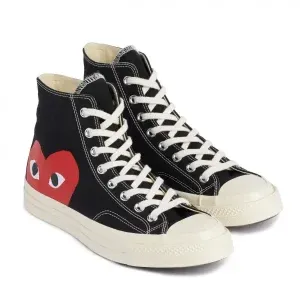How Comme des Garçons Changed Fashion Forever

Fashion is not merely about fabric, color, or form. It’s a language — one that communicates personality, rebellion, and art. Few brands capture this dialogue between creativity and culture as powerfully as Comme des Garçons. Born in the heart of Japan but celebrated worldwide, this avant-garde fashion house has redefined what it means to dress differently.
Through the genius of its founder, Rei Kawakubo, Comme des Garçons has consistently challenged conventions and turned fashion into an expressive form of conceptual art. From deconstructed tailoring to exaggerated silhouettes, the brand is not just about clothing — it’s about an attitude.
The Birth of a Revolutionary Fashion Vision
Rei Kawakubo founded Comme des Garçons in Tokyo in 1969. The name, which translates to “like boys” in French, symbolizes the genderless and rebellious philosophy that became central to the brand’s DNA.
In a time when Western fashion was synonymous with glamour and perfection, Kawakubo presented a vision rooted in imperfection, asymmetry, and abstraction. Her approach was radical — garments with holes, distressed fabrics, unfinished hems, and unconventional shapes. What others considered flaws, Kawakubo saw as beauty.
By the early 1980s, Comme des Garcons had already made waves in Paris. Its first runway shows shocked the audience — models dressed in black, wearing oversized and distressed clothing, a stark contrast to the polished and luxurious aesthetic that dominated fashion at the time. Critics initially called it “Hiroshima chic,” but soon the world understood that Kawakubo was not following trends — she was creating them.
The Philosophy Behind Comme des Garçons
At its core, Comme des Garçons is not about clothing as mere attire. It’s about philosophy, emotion, and breaking boundaries. Kawakubo often designs collections that explore abstract concepts — from love and death to chaos and beauty. Her creative process begins not with sketches but with ideas, emotions, and questions about society.
Each garment is an experiment. Shapes are distorted, fabrics are layered in unpredictable ways, and colors are often muted to emphasize structure and form. This approach makes Comme des Garçons clothing feel more like wearable sculptures than traditional fashion pieces.
Kawakubo’s philosophy rejects the notion of commercial conformity. She once said, “I create clothes for a woman who is not swayed by what her husband thinks.” This statement perfectly captures the brand’s independence and power. Comme des Garçons celebrates individuality — it invites the wearer to be bold, to challenge norms, and to find beauty in imperfection.
The Signature Aesthetic
The aesthetic of Comme des Garçons clothing is instantly recognizable. Black has always played a dominant role, symbolizing simplicity and depth. But beyond color, it’s the form that speaks the loudest.
From asymmetrical cuts and exaggerated proportions to the juxtaposition of rough and delicate textures, each piece is designed to provoke thought. Many garments lack a defined shape or gender, reflecting Kawakubo’s challenge to fashion’s traditional binaries.
Comme des Garçons also embraces deconstruction — tearing apart garments only to reassemble them in unexpected ways. This technique symbolizes the destruction and rebirth of ideas, a central theme throughout the brand’s evolution.
Collaboration and Expansion
While Comme des Garçons began as a niche avant-garde label, it has grown into a global fashion powerhouse with numerous sub-lines and collaborations. One of its most successful and widely recognized ventures is the Comme des Garçons PLAY line — a more casual and accessible collection that still carries the brand’s artistic spirit.
The PLAY collection is known for its iconic heart-with-eyes logo designed by artist Filip Pagowski. It represents a playful twist on the brand’s otherwise serious aesthetic. The line has become especially popular for its collaborations with other brands, notably the cdg converse sneakers.
The cdg converse partnership transformed a simple sneaker into a statement piece. Combining Converse’s timeless silhouette with Comme des Garçons’ bold heart logo, the shoe became an instant fashion favorite — bridging the gap between streetwear and high fashion. It’s a perfect example of how the brand balances avant-garde artistry with everyday wearability.
Similarly, the comme des garcons shirt line brings a reinterpretation of classic menswear staples. Instead of traditional tailoring, the shirts feature unexpected cuts, patchwork details, and experimental proportions. Each piece challenges the definition of what a shirt can be, making it both a fashion item and a work of art.
The Role of Rei Kawakubo in Modern Fashion
Rei Kawakubo remains one of the most influential figures in contemporary fashion. Her work has inspired countless designers and has been exhibited in museums around the world, including a solo exhibition at the Metropolitan Museum of Art’s Costume Institute — a rare honor for a living designer.
Her approach to design is deeply intellectual. She often uses her collections to explore philosophical questions about identity, destruction, and creation. Rather than following fashion trends, she dissects them. Through Comme des Garçons, she has built a universe where clothing becomes a tool for storytelling and rebellion.
The Comme des Garçons Experience
Shopping for Comme des Garçons clothing is not like visiting a regular fashion store. The brand’s boutiques are designed to feel like art installations — spaces where architecture, sound, and design interact to create an emotional experience.
Each store has its own distinct concept, often reflecting the spirit of the local culture while staying true to the brand’s avant-garde ethos. Walking into a Comme des Garçons store feels like stepping into another world — one where creativity reigns and convention disappears.
The staff, often dressed in minimalist uniforms, treat fashion as art curation. Instead of pushing sales, they focus on guiding the customer through the brand’s philosophy. This experiential approach enhances the emotional connection between the brand and its audience.
Cultural Influence and Legacy
Over the decades, Comme des Garçons has transcended the world of fashion to influence art, design, and culture. The brand has collaborated with artists, musicians, and other designers, continually expanding its creative boundaries.
Its influence can be seen in everything from contemporary art installations to streetwear movements. In an age dominated by fast fashion, Comme des Garçons stands as a beacon of authenticity and intellectual depth. Each collection tells a story, challenges expectations, and pushes fashion forward.
Celebrities and style icons across the world have embraced the label for its distinctiveness. Whether it’s on runways, in art galleries, or in music videos, Comme des Garçons represents a fearless approach to self-expression.
Sustainability and Future Vision
In recent years, as fashion faces growing scrutiny for its environmental impact, Comme des Garçons has quietly adopted more mindful practices. While never driven by trends, the brand values longevity, quality, and creativity over mass production.
Rei Kawakubo has always emphasized the idea of timelessness — creating garments that last, both physically and conceptually. This mindset naturally aligns with sustainable fashion principles. Rather than chasing disposable trends, Comme des Garçons encourages thoughtful consumption and appreciation for artistry.
Looking ahead, the brand continues to evolve without losing its core identity. Under the creative leadership of Kawakubo and her protégés, Comme des Garçons remains committed to redefining what fashion means in the modern world — not through conformity, but through courage.
Why Comme des Garçons Endures
The enduring success of Comme des Garçons clothing lies in its fearless originality. While many fashion houses rely on predictability, Comme des Garçons thrives on surprise. Each season brings new ideas, new silhouettes, and new interpretations of beauty.
It’s a brand that speaks to those who value creativity over conformity — to individuals who see fashion not as decoration, but as a declaration. From the artful construction of the comme des garcons shirt to the iconic simplicity of cdg converse, every product carries the same DNA of innovation and rebellion.
Ultimately, Comme des Garçons is more than a fashion brand — it’s a cultural movement. It reminds the world that true style comes from within, from the courage to question, disrupt, and redefine.
Conclusion
In the vast universe of fashion, Comme des Garçons stands apart as a symbol of avant-garde freedom. Rei Kawakubo’s vision continues to inspire generations of designers, artists, and thinkers to see fashion not just as clothing, but as philosophy.
From radical runways to everyday collaborations, the brand balances intellectual depth with modern relevance. Whether through the artistic folds of a jacket, the simplicity of a comme des garcons shirt, or the effortless cool of cdg converse, the message remains the same — beauty lies in difference.
Comme des Garçons will always be for those who dare to be different, who see beyond the ordinary, and who believe that fashion is not just about what we wear, but how we think.






